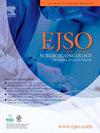Prognostic impact of myopenia and establishment of a nomogram for predicting survival following radical gastrectomy in patients with gastric cancer: A multicenter study
IF 2.9
2区 医学
Q2 ONCOLOGY
引用次数: 0
Abstract
Introduction
The prognostic value of myopenia following radical gastrectomy (RG) remains controversial.
Materials and methods
Patients who underwent RG between January 2015 and December 2018 at two East Asian centers were retrospectively included. Myopenia was defined using sex-specific computed tomography-derived L3 skeletal muscle index, with cut-off values determined by X-tile software based on overall survival (OS). Cox regression models identified independent prognostic factors for OS and disease-free survival (DFS), whereas logistic regression identified risk factors for textbook outcomes (TO). A LASSO-based prognostic nomogram was developed, and its performance was evaluated using calibration curves, concordance index, time-dependent receiver operating characteristic, and decision curve analysis.
Results
Overall, 943 patients were included (211 and 732 with and without myopenia, respectively). The myopenia group had a significantly lower TO rate (P = 0.003), and myopenia was confirmed as an independent risk factor for TO failure (P < 0.05). Moreover, the myopenia group had significantly lower 5-year OS (45.5 % vs. 69.3 %, P < 0.001) and DFS (45.0 % vs. 66.8 %, P < 0.001), with myopenia independently associated with poor prognosis. The nomogram developed in this study outperformed the tumor-node-metastasis staging system in predicting 3- and 5-year OS (both P < 0.05), demonstrating superior net clinical benefits across a threshold range of 10 %–80 %. Risk stratification effectively discriminated 5-year OS (94.3 % vs. 61.2 % vs. 24.2 %, P < 0.001). These results were reproduced in the validation cohort.
Conclusions
Myopenia independently predicts both short-term outcomes and long-term prognosis after RG. The myopenia-integrated nomogram showed strong predictive accuracy and clinical utility for individualized prognostic assessment of patients with gastric cancer.
一项多中心研究:胃癌根治性胃切除术后肌萎缩对预后的影响及建立预测生存的nomogram (nomogram)
导言:胃癌根治术(RG)后肌萎缩的预后价值仍有争议。材料和方法:回顾性纳入2015年1月至2018年12月在两个东亚中心接受RG的患者。使用性别特异性计算机断层扫描衍生的L3骨骼肌指数来定义肌萎缩症,并根据总生存期(OS)使用X-tile软件确定临界值。Cox回归模型确定了OS和无病生存期(DFS)的独立预后因素,而逻辑回归确定了教科书结局(TO)的危险因素。建立了基于lasso的预后模态图,并通过校准曲线、一致性指数、随时间变化的受试者工作特征和决策曲线分析来评估其性能。结果:共纳入943例患者(分别为211例和732例)。肌减少组TO发生率明显低于对照组(P = 0.003),肌减少是TO失败的独立危险因素(P结论:肌减少可独立预测RG术后的短期结局和长期预后。在胃癌患者的个体化预后评估中,肌萎缩综合nomogram显示出很强的预测准确性和临床实用性。
本文章由计算机程序翻译,如有差异,请以英文原文为准。
求助全文
约1分钟内获得全文
求助全文
来源期刊

Ejso
医学-外科
CiteScore
6.40
自引率
2.60%
发文量
1148
审稿时长
41 days
期刊介绍:
JSO - European Journal of Surgical Oncology ("the Journal of Cancer Surgery") is the Official Journal of the European Society of Surgical Oncology and BASO ~ the Association for Cancer Surgery.
The EJSO aims to advance surgical oncology research and practice through the publication of original research articles, review articles, editorials, debates and correspondence.
 求助内容:
求助内容: 应助结果提醒方式:
应助结果提醒方式:


